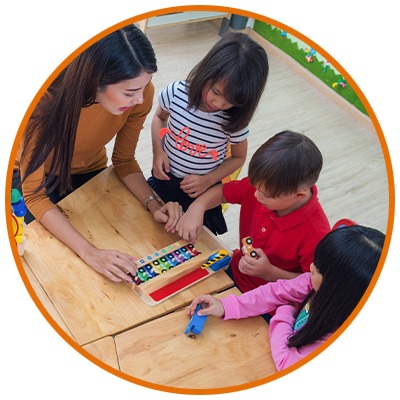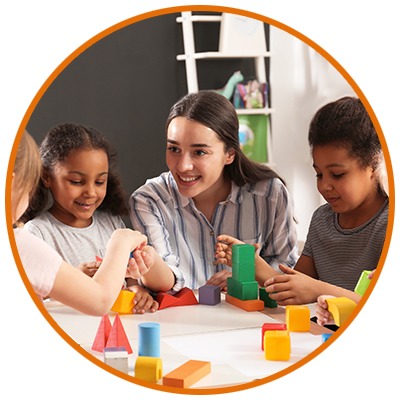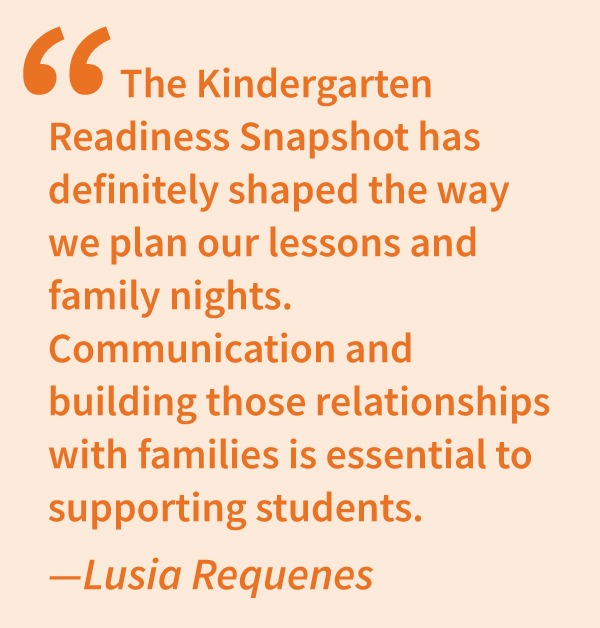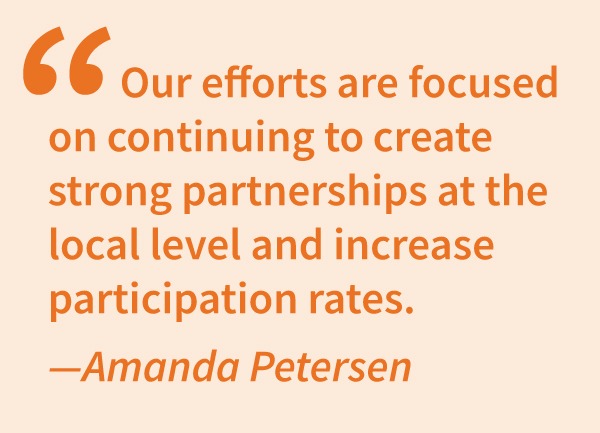KSDE’s search for a reliable tool that would easily lend itself to statewide implementation led them to the widely trusted developmental screener ASQ-3 and social-emotional screener ASQ:SE-2.
One immediate benefit was that many Kansas programs were already using the ASQ screeners. The state’s education department also found it appealing that the tool is not only a screener, but also a child development system that emphasizes the importance of nurturing crucial skills—including social-emotional skills—from birth. And it’s designed to forge strong connections with families so they can help support their child’s progress between screenings.
“ASQ’s focus on social-emotional readiness was a driving force,” says Petersen. “We were also looking to engage families more and start building that positive relationship with parents early on.”
A Promising Pilot
 ASQ seemed like a promising choice to help achieve the outcomes prioritized by Commissioner Watson and the Kansas State Board of Education, but KSDE still needed to gather critical data to gauge the cost, feasibility, and efficacy of a statewide rollout. In spring 2016, the department tapped resources from the Kansas Children’s Cabinet and Trust Fund to subsidize an ASQ pilot program that would begin that fall and involve 62 schools in 37 districts across the state.
ASQ seemed like a promising choice to help achieve the outcomes prioritized by Commissioner Watson and the Kansas State Board of Education, but KSDE still needed to gather critical data to gauge the cost, feasibility, and efficacy of a statewide rollout. In spring 2016, the department tapped resources from the Kansas Children’s Cabinet and Trust Fund to subsidize an ASQ pilot program that would begin that fall and involve 62 schools in 37 districts across the state.
With only a few months to get all the administrators, teachers, and staff from the pilot cohort versed in administering ASQ, Brookes Publishing, and Kansas Child Care Training Opportunities, Inc., (KCCTO) held ASQ Training of Trainers Institutes over the summer of 2016. These intensive two-day seminars gave attendees an expert-led walkthrough on using ASQ-3 and ASQ:SE-2, with Institute graduates then returning to their districts and programs to train colleagues on effective screening with ASQ.
Meanwhile, the initiative faced another challenge. Children in Kansas can start kindergarten once they have turned 5 years of age on or before August 31 of the current school year, but the oldest age for the 60 month ASQ-3 questionnaire is only 66 months. (For ASQ:SE-2, the 60 month questionnaire can be used for children up to 72 months, so the entire age span was covered for social-emotional screening.) The ASQ author group had already started work on a 72 month questionnaire to include in the next edition of ASQ, and Kansas schools were provided access to the pilot version that could be used for children who might have just missed the age cutoff to attend school the previous school year. “We were excited to use this opportunity to gather data on the new questionnaire interval and provide a solution to a barrier for Kansas schools,” says Sam Schissler, national sales manager for Brookes Publishing. “It was basically a pilot within a pilot.”
The Kindergarten Readiness Snapshot pilot program began in the fall of 2016, engaging 2,200 kindergarten students and 2,600 families in both urban and rural districts of Kansas. Feedback from participants was encouraging:
- Over 90 percent of the 180 teachers in the pilot cohort reported that ASQ items focused on key kindergarten readiness skills.
- 76 percent agreed that ASQ Online was user-friendly.
- Nearly 70 percent said that ASQ questionnaires would be useful to teachers in the classroom.
 Now equipped with real-world data, KSDE received approval from the Kansas State Board of Education in spring 2017 to begin drafting a detailed request for proposal. The state board of education approved the request later that summer, and following a request for proposal process, ASQ was officially selected as Kansas’s Kindergarten Readiness Snapshot tool. Brookes again partnered with KCCTO to hold eight additional ASQ Training of Trainers Institutes in the state.
Now equipped with real-world data, KSDE received approval from the Kansas State Board of Education in spring 2017 to begin drafting a detailed request for proposal. The state board of education approved the request later that summer, and following a request for proposal process, ASQ was officially selected as Kansas’s Kindergarten Readiness Snapshot tool. Brookes again partnered with KCCTO to hold eight additional ASQ Training of Trainers Institutes in the state.
Implementation Ups and Downs
Three years after Dr. Watson’s inaugural listening tour, the first Kindergarten Readiness Snapshot window opened in every school district throughout Kansas. Schools had from August 1 to September 20, 2018 to partner with parents in administering ASQ:3 and ASQ:SE-2 to all incoming kindergartners. Schools were required to purchase ASQ-3 and ASQ:SE-2 Starter Kits and were able to access ASQ Online and ASQ Family Access through an ASQ Enterprise subscription supplied by KSDE.
 From the start, education officials made it clear to parents that the Kindergarten Snapshot wouldn’t prevent children from entering kindergarten: “We wanted them to know that ASQ is an opportunity to personalize instruction for their child as they enter kindergarten, not a tool to screen them out of kindergarten,” says Petersen.
From the start, education officials made it clear to parents that the Kindergarten Snapshot wouldn’t prevent children from entering kindergarten: “We wanted them to know that ASQ is an opportunity to personalize instruction for their child as they enter kindergarten, not a tool to screen them out of kindergarten,” says Petersen.
Like any new large-scale initiative, the Kindergarten Snapshot experienced some challenges:
- Tech issues stemming from thousands of users simultaneously acquainting themselves with a new online system. “That first year, roughly half the calls we received were to help people reset their [ASQ Online] username and password,” says Petersen.
- Parent misgivings: “Some families communicated their hesitancies, because they had never been asked to provide this level of feedback in specific ways across all domains of learning and development,” says Melissa Harlan, an early learning instructor at USD 386 Madison.
- Skepticism about ASQ’s reliance on family reporting: Some professionals were worried that parents may not complete the questionnaires correctly. (View this fact sheet to learn why parent-completed questionnaires are effective.)
- The logistics of scaling up ASQ implementation for 286 public school districts and approximately 70 accredited private systems. “The resources that a district with 12 incoming kindergartners has is very different from the resources available to a larger district,” says Petersen. “But schools have been able to try out different strategies and come up with some creative solutions.”
Those solutions included Kindergarten Readiness fairs, featuring free backpack giveaways and restaurant gift cards for families, and back-to-school nights with questionnaire completion booths and activity stations run by high school student volunteers. USD 386 began hosting a successful ASQ Family Night: “We have ‘come-and-go’ style stations that include manipulatives for each part of ASQ-3 as well as professional staff to address any questions or clarifications,” says Harlan. “We also provide supervised child care on the playground and a quieter space for families to complete ASQ:SE-2.”
 Emerson Elementary School in Kansas City also found ASQ Family Nights to be an effective way to increase family engagement while maintaining a healthy (over 95%) completion rate. “We make it an open-house-style event and offer food to encourage families to come out,” says Lusia Requenes, a school-family community specialist at Emerson. “We have stations set up for each area of the questionnaires, with staff and interpreters available to assist at each station.”
Emerson Elementary School in Kansas City also found ASQ Family Nights to be an effective way to increase family engagement while maintaining a healthy (over 95%) completion rate. “We make it an open-house-style event and offer food to encourage families to come out,” says Lusia Requenes, a school-family community specialist at Emerson. “We have stations set up for each area of the questionnaires, with staff and interpreters available to assist at each station.”
At USD 309 Nickerson-South Hutchinson, ASQ screenings are part of an early childhood wellness event that also includes by-appointment screenings for hearing, vision, dental, and overall health. “We set up a room with computers, supplies, and assistants for parents to complete the ASQ questionnaires,” says Penny Stoss, assistant superintendent at USD 309. “This is helpful because our data is immediately ready for us to create group reports and get it back to the teachers quickly. They use the data at their first professional learning community of the year to discuss teaching strategies for each child and determine which classrooms may need additional paraprofessional support.”
Emerson also provided an example of how programs can use ASQ data to target instruction where children need it most. After discovering that their 2019 class of incoming kindergartners scored lowest on fine motor skills, Emerson’s next Kindergarten Family Night consisted of sharing ASQ results and then having families work with their child at activity stations where they could glue beads, shape dough, and use shaving cream to form letters.
Harlan also appreciates how ASQ strengthens the link between classroom and home by placing families at the center of the screening process. “As a teacher, I value the input included in the narrative answers at the end [of each questionnaire]. This provides me with specific individualized feedback directly from the family,” she says. “I also get the impression that families feel more a part of the process of ‘next steps’ in learning and a sense of how we value their input.”
Stoss agrees that strengthening the home–school alliance is one of the top benefits of the ASQ process. “The screening data gives them a common ground to begin working as a team and host meaningful conversations about the whole child,” she says. “ASQ helps build the parent-teacher relationship early in the school year, laying the groundwork for future open communication.”
Staying Connected During COVID-19
 The COVID-19 pandemic has caused massive learning disruptions across the country, but it’s not yet clear what impact the past 18 months have had on Kansas’s screening initiative. Petersen says although the state has seen a drop in preschool enrollment since the beginning of the pandemic, it’s too soon to tell whether there has been a noticeable uptick in referrals for intervention services for incoming kindergartners.
The COVID-19 pandemic has caused massive learning disruptions across the country, but it’s not yet clear what impact the past 18 months have had on Kansas’s screening initiative. Petersen says although the state has seen a drop in preschool enrollment since the beginning of the pandemic, it’s too soon to tell whether there has been a noticeable uptick in referrals for intervention services for incoming kindergartners.
Reporting from the local level, Melissa Harlan says that USD 386 Madison has been doing full-time, in-person learning since May 2020, and there have been no identifiable changes in participation or referral rates over the past 18 months. Screening rates have essentially stayed the same at USD 309 since the pandemic’s onset, according to Stoss, but she noted that they have seen a slight increase in kindergartners scoring lower in both the problem solving and social-emotional areas of ASQ. Lusia Requenes says Emerson garnered favorable completion rates during the pandemic by posting the Family Access links for completing ASQ on the school website and providing virtual tech support for families as they navigated the ASQ:3 and ASQ:SE-2 questionnaires.
Making Changes, Moving Forward
KSDE has received its own education the past four years, as the screening initiative continues to evolve. What might the department do differently if they had the Kindergarten Readiness Snapshot implementation process to do over again?
“There’s that saying, ‘Go slow to go fast,’” says Petersen. “Ideally we would have had more time and been able to build collaborative relationships on the front end at the district level and made sure everyone was clear on the processes early on. I compare it to drinking from a firehose. Just to get this on people’s radar has been an ongoing challenge.”
One of the most requested changes from educators during the first two years of the initiative was to move up the opening of the Kindergarten Readiness Snapshot screening window, allowing more time for kindergarten staff to work with families on administering ASQ to all incoming students. In 2020, the screening window was expanded to a 12-week period from July 1 to September 20, and in 2021, the opening of the window was moved up to March 1 so programs could introduce ASQ to parents and families at their annual Kindergarten Round-Up in the spring.
Participation in the Kindergarten Readiness Snapshot initiative has increased each year, due largely to improvements in implementation at the district level. According to KSDE, programs entered 43,906 total ASQ screenings during the first year of the initiative in 2018, while in 2021, a combined 70,918 ASQ-3 and ASQ:SE-2 screenings were logged.
 Petersen says that KSDE would like to see the 2021 participation rate of 58% eventually increase to much closer to 100% unless families opt out or teachers collaborate with families to determine that the ASQ should not be used. “We need higher participation rates to make a great representative sample so we can then say, ‘OK, we need to prepare children for x, y and z, and here’s how we can adapt our programs to cater to those needs.’”
Petersen says that KSDE would like to see the 2021 participation rate of 58% eventually increase to much closer to 100% unless families opt out or teachers collaborate with families to determine that the ASQ should not be used. “We need higher participation rates to make a great representative sample so we can then say, ‘OK, we need to prepare children for x, y and z, and here’s how we can adapt our programs to cater to those needs.’”
Positive, lasting effects on child development and kindergarten readiness in the state won’t be the result of a single initiative or agency, but must be part of a continuous push involving multiple entities in every community. Petersen points to the United Way of Reno’s K-Ready Coalition—a group of local organizations in Hutchinson and Reno counties that aims to improve access to child care and equip families to support healthy child development—as a good example of the kind of cooperative early childhood resource-building that can help boost successful outcomes for all young children.
While local communities do their part to help ensure the long-term success of each Kansas student, the state has continued its commitment to building an infrastructure that promotes age-appropriate child development. As of July 2020, any early childhood program in the state can now administer ASQ to any child they serve, with KSDE covering the screening costs as part of the state’s All In for Kansas Kids strategic plan for early childhood funded by the federal Preschool Development Grant Birth through Five.
With this impressive expansion of the initiative, the state of Kansas is ensuring more children under 5 are screened, which allows potential concerns to be addressed and improves overall kindergarten readiness.
You can learn more about the Kansas Kindergarten Readiness Snapshot Initiative on the Kansas State Department of Education’s website.
 The long-term success of any student depends on many variables, but research points to one factor as being especially critical to positive outcomes for young children: kindergarten readiness. Accordingly, many states use assessments to gauge where children are developmentally as they enter kindergarten, and to gather important information for educators as they determine which areas of development to prioritize for each child during their first year of school.
The long-term success of any student depends on many variables, but research points to one factor as being especially critical to positive outcomes for young children: kindergarten readiness. Accordingly, many states use assessments to gauge where children are developmentally as they enter kindergarten, and to gather important information for educators as they determine which areas of development to prioritize for each child during their first year of school.

 ASQ seemed like a promising choice to help achieve the outcomes prioritized by Commissioner Watson and the Kansas State Board of Education, but KSDE still needed to gather critical data to gauge the cost, feasibility, and efficacy of a statewide rollout. In spring 2016, the department tapped resources from the Kansas Children’s Cabinet and Trust Fund to subsidize an ASQ pilot program that would begin that fall and involve 62 schools in 37 districts across the state.
ASQ seemed like a promising choice to help achieve the outcomes prioritized by Commissioner Watson and the Kansas State Board of Education, but KSDE still needed to gather critical data to gauge the cost, feasibility, and efficacy of a statewide rollout. In spring 2016, the department tapped resources from the Kansas Children’s Cabinet and Trust Fund to subsidize an ASQ pilot program that would begin that fall and involve 62 schools in 37 districts across the state.  Now equipped with real-world data, KSDE received approval from the Kansas State Board of Education in spring 2017 to begin drafting a detailed request for proposal. The state board of education approved the request later that summer, and following a request for proposal process, ASQ was officially selected as Kansas’s Kindergarten Readiness Snapshot tool. Brookes again partnered with KCCTO to hold eight additional ASQ Training of Trainers Institutes in the state.
Now equipped with real-world data, KSDE received approval from the Kansas State Board of Education in spring 2017 to begin drafting a detailed request for proposal. The state board of education approved the request later that summer, and following a request for proposal process, ASQ was officially selected as Kansas’s Kindergarten Readiness Snapshot tool. Brookes again partnered with KCCTO to hold eight additional ASQ Training of Trainers Institutes in the state. From the start, education officials made it clear to parents that the Kindergarten Snapshot wouldn’t prevent children from entering kindergarten: “We wanted them to know that ASQ is an opportunity to personalize instruction for their child as they enter kindergarten, not a tool to screen them out of kindergarten,” says Petersen.
From the start, education officials made it clear to parents that the Kindergarten Snapshot wouldn’t prevent children from entering kindergarten: “We wanted them to know that ASQ is an opportunity to personalize instruction for their child as they enter kindergarten, not a tool to screen them out of kindergarten,” says Petersen.  Emerson Elementary School in Kansas City also found ASQ Family Nights to be an effective way to increase family engagement while maintaining a healthy (over 95%) completion rate. “We make it an open-house-style event and offer food to encourage families to come out,” says Lusia Requenes, a school-family community specialist at Emerson. “We have stations set up for each area of the questionnaires, with staff and interpreters available to assist at each station.”
Emerson Elementary School in Kansas City also found ASQ Family Nights to be an effective way to increase family engagement while maintaining a healthy (over 95%) completion rate. “We make it an open-house-style event and offer food to encourage families to come out,” says Lusia Requenes, a school-family community specialist at Emerson. “We have stations set up for each area of the questionnaires, with staff and interpreters available to assist at each station.” The COVID-19 pandemic has caused massive learning disruptions across the country, but it’s not yet clear what impact the past 18 months have had on Kansas’s screening initiative. Petersen says although the state has seen a drop in preschool enrollment since the beginning of the pandemic, it’s too soon to tell whether there has been a noticeable uptick in referrals for intervention services for incoming kindergartners.
The COVID-19 pandemic has caused massive learning disruptions across the country, but it’s not yet clear what impact the past 18 months have had on Kansas’s screening initiative. Petersen says although the state has seen a drop in preschool enrollment since the beginning of the pandemic, it’s too soon to tell whether there has been a noticeable uptick in referrals for intervention services for incoming kindergartners.  Petersen says that KSDE would like to see the 2021 participation rate of 58% eventually increase to much closer to 100% unless families opt out or teachers collaborate with families to determine that the ASQ should not be used. “We need higher participation rates to make a great representative sample so we can then say, ‘OK, we need to prepare children for x, y and z, and here’s how we can adapt our programs to cater to those needs.’”
Petersen says that KSDE would like to see the 2021 participation rate of 58% eventually increase to much closer to 100% unless families opt out or teachers collaborate with families to determine that the ASQ should not be used. “We need higher participation rates to make a great representative sample so we can then say, ‘OK, we need to prepare children for x, y and z, and here’s how we can adapt our programs to cater to those needs.’”